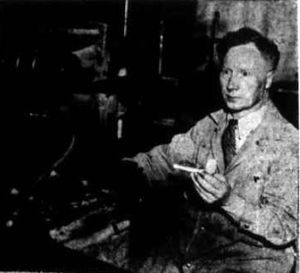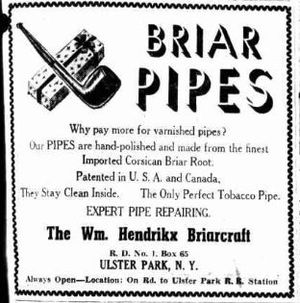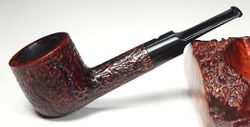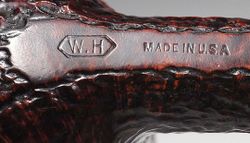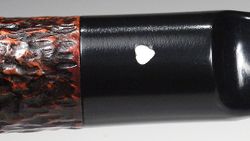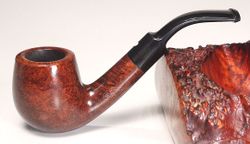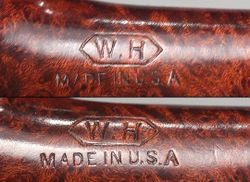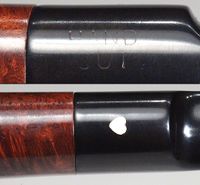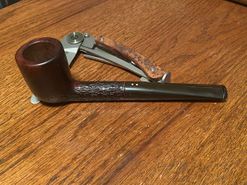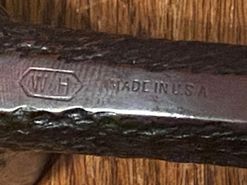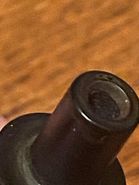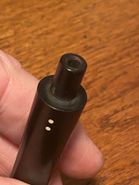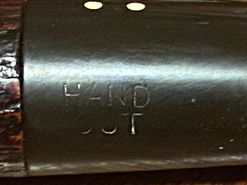William H. Hendrikx: Difference between revisions
C.A.Lang.525 (talk | contribs) No edit summary |
No edit summary |
||
| (12 intermediate revisions by 3 users not shown) | |||
| Line 1: | Line 1: | ||
[[File:Hendrikx c1939.JPG|thumb|Hendrikx at his workshop c. 1939]] | |||
[[File:Hendrikx pipes 1940.JPG|thumb|Advertisement c. 1940-41]] | |||
William | |||
[[William H. Hendrikx]] was born in Amsterdam, Holland in 1882. Through his father he learned fluency in several languages; considering his father was a teacher of language, these attributes to his upbringing could have turned him down a much different path in life. But at a young age, Hendrikx knew his interests lay in craftsmanship. | |||
While still young he had the opportunity to visit a pipe factory in Holland. He was intrigued enough that he secured a part time position at the factory and began his early education in the art of pipe making. | While still young he had the opportunity to visit a pipe factory in Holland. He was intrigued enough that he secured a part time position at the factory and began his early education in the art of pipe making. | ||
Sometime around 1906, he immigrated to Quebec, Canada, where he likely continued his profession as a pipe maker possibly in the employ of a large company. By 1915 he had immigrated to Long Island, New York, United States. In America, he once again continued his profession in the briar pipe industry. This time acting as a manager for several pipe manufacturers. | Sometime around 1906, he immigrated to Quebec, Canada, where he likely continued his profession as a pipe maker possibly in the employ of a large company. By 1915 he had immigrated to Long Island, New York, United States. In America, he once again continued his profession in the briar pipe industry. This time acting as a manager for several pipe manufacturers. | ||
As early as 1923 he managed the | As early as 1923 he managed the [[A. Frankau & Co.]], Inc of College Point, NY . This manufacturer used the idea that in comparison to European makers, (ex. English company that hires foreigners to work in their mills due to lack of local craftsmanship from their own countrymen) an American company that hires a completely American workforce could produce pipe of the same if not higher quality. | ||
Over the next two decades, he would act a manager of both the | Over the next two decades, he would act a manager of both the [[BBB]] Pipes (A. Frankau's American factory) and Hesson Pipes Companies, both located in College Point, LI. | ||
His next move would be to attempt his hand at farming in Ulster County, New York. The stock market crash put his plans of countryside leisure on hold and he was pushed back into the work of his calling. | His next move would be to attempt his hand at farming in Ulster County, New York. The stock market crash put his plans of countryside leisure on hold and he was pushed back into the work of his calling. | ||
This time setting up shop in Ulster Park, Town of Esopus, Ulster County, New York, he began producing handmade pipes in a personal barn style workshop. His name was already known to a few in the industry, but the slogan of “Buy American Products” painted in large lettering on the side of his shop, and a roadside sign advertising “William Hendrikx, Briarcraft Pipes for Sale”, drew enough local and by-passer attention that he was able to maintain a reputable business. [[File: | This time setting up shop in Ulster Park, Town of Esopus, Ulster County, New York, he began producing handmade pipes in a personal barn style workshop. This would have been c. 1928. His name was already known to a few in the industry, but the slogan of “Buy American Products” painted in large lettering on the side of his shop, and a roadside sign advertising “William Hendrikx, Briarcraft Pipes for Sale”, drew enough local and by-passer attention that he was able to maintain a reputable business. | ||
Mr. Hendrikx also held a 1934 patent (US1952862 A) for an improvement to the tobacco pipe (see bellow), inclusive of a filtration system in the stem, assigned by him to the [[William Demuth Company]]. There is reference to the patent never being officially sold due to financial related issues. The stem he invented would be featured on many of his own pipes made in his Ulster Park shop. | |||
According to the NYS Health Department's records, William Hendrikx passed away on the 23rd of August, 1961. The Kingston DailyFreeman issued a short paragraph on his departure, attributing it to a self inflicted gunshot wound to the head. He had apparently been in ill health the last two years of his life and could no longer physically carve his pipes. | |||
<gallery widths=250 heights=185 caption="Examples and details, courtesy Doug Valitchka"> | |||
File:WH01.jpg | |||
File:WH07.jpg | |||
File:WH08.jpg | |||
WH2-01.jpg | |||
WH2-07.jpg | |||
WH2-08.jpg | |||
</gallery> | |||
<gallery widths=250 heights=185 caption="Perhaps an earlier example, with a two dot logo as opposed to the heart examples above. The tenon chamfer is similar to the patent but different, perhaps on the way to it, courtesy Tim Lomprey"> | |||
WilliamHendrikx.jpg | |||
WilliamHendrikx2.jpg | |||
WilliamHendrikx3.jpg | |||
WilliamHendrikx4.jpg | |||
WilliamHendrikx5.jpg | |||
</gallery> | |||
[[File:HendrikxPatentUS1952862-drawings-page-1.png|thumb|500px|1934 Patent, courtesy [https://patents.google.com/patent/US1952862 Google]]] | |||
'''The following is the patent text from the application dated July 31, 1931, and granted March 27, 1934:''' | |||
<blockquote> | |||
'''Description''' | |||
March 27, 1934. w HEDRlKx f 1,952,862 | |||
TOBACCO PIPE Filled July 31, 1931 BY @MWL Patented Mar. 27, 1934 UNITED STATES PATENT OFFICES TOBACCO PIPE, William Hendrikx, Ulster Park, N. Y., assignor to .Y William De Muth & Company, New York, N. Y., a corporation of New York Application July 31, 1931, Serial No. 554,168' | |||
'''l Claims.''' | |||
This invention relates to tobacco pipes and has particular reference to improvements in pipes having metal tubular connections in the stems to provide smoke passages, which are especially inducive to clean, dry smokes, and which avoid, as far as possible, any tendency to serve as collecting means for tobacco juice and saliva. | |||
The present invention has for its object to provide a pipe of this character wherein the metal tubular connection is made in two sections which telescope one within the other to establish a perfectly tight smoke joint between the bowl and mouthpiece. | |||
Another object of my invention is to V nx the separate sections of the connection in the mouthpiece and pipe stem respectively, so as to establish perfect smoke tight joints at these points. | |||
Still another object of this invention is to provide one of the sections of the tubular connection with a smoke passage which is reduced in diameter towards the tip end for the purpose of preventing the saliva from flowing towards the bowl and mixing with the tobacco fumes to form tobacco juice. | |||
have accomplished these objects by means of a construction and arrangement of parts hereinafter described, set forth in the appended claims and illustratively exemplified in the accompanying drawing in which: Figure 1 is a substantially longitudinal sectional view of a pipe embodying my improved metal tubular connection; Figure 2 is a side elevational View of one embodiment of the tubular connection; and Figure 3 is a similar view of a slightly modified form .f of construction. | |||
Referring to the drawing, 10 is the bowl of a smoking pipe, 11 the stern and 12 the mouthpiece. As illustrated in Figure 1 the stem l1 is formed with a bore 11a projecting from one end to a point short of the recess in the bowl, and in communication with the latter through a reduced passage 13, the inner end of the mouthpiece is provided with a tenon 14 which is received in the open end of the bore 11a. | |||
The passage 13 in the form of the invention illustrated in Figure 1 is enlarged at its inner end and internally threaded to receive the threaded end 15 of a spigot 16 which comprises a metal member having a collar 17, substantially midway of its length, abutting the end wall of the bore 11a, and a shank 18 projecting axially into the latter and having a rounded end, the spigot being provided with a uniform bore 19 opening at the threaded end in the smaller portion of the reduced passage 13 of the stem 11. In the modification shown in Figure 3 the end of the spigot is provided with a knurled surface 20 which is-cemented in the enlarged end of the passage 13 of the stem. | |||
The mouthpiece 12 is provided with a bore 21 which is enlarged in the tenon 14 and for a short distance into the body of the mouthpiece itself to accommodate one end of a tubular metal piece 22 which is either knurled and cemented into the tenon and mouthpiece, as illustrated in Figures 1 and 3, or provided with an external thread 23 and screwed into an inner threaded portion of the enlarged portion of the bore 21, as illustrated in Figure 2. The tubular piece 22 is also provided with an axial bore 24 which is arranged 70 .l in three steps, the first, at the outer end being of a diameter to very closely embrace the shank end of the spigot 16 and having a rounded seat to receive the rounded end of the shank. The mid section of the bore 24 is substantially smaller than that of the outer section and it terminates short of its mouthpiece end in a beveled shoulder 25 which opens into the third section of the bore 24, the dimension of the latter section kbeing reduced as compared with the second section to correspond with the dimension of the bore Vor smoke passage 2l, in the mouthpiece i2, into which it opens. | |||
To assemble the pipe, according to the invention, the mouthpiece tenon 14 with its projecting metal extension piece 22 is inserted into the bore 11a of the pipe stem 11 to a point where the inner end of the first section of the bore 24 is seated against the round end of the spigot shank 18. When the metal extension piece 22 has reached this point the tenon 14 will have been projected its full length into the bore of the stem 11 and the end of the mouthpiece will be seated against the end of the stem. | |||
The wall of the bore in the outer section of the extension 22 embraces the shank 18 very closely and the joint thus formed is leak proof, thereby preventing any nicotine or moisture from finding its way into the bore 11a of the stem, which as a consequence remains dry and clean. The joint made by the connection of the spigot and tubular extension would remain tight even if a strand of tobacco were to lodge in the seat of the extension because as stated above the wall or shell of the latter is snugly over the shank 18 throughout its length. | |||
According to the present invention, the construction and arrangement of the tubular section piece 22 and spigot 16 greatly strengthens the pipe stem 11 and mouthpiece 12, making them practically rigid when assembled. | |||
The through smoke passage 24 in the extension piece 22 and spigot directs the smoke from the bowl 10 to contact with the cool metal wall of the spigot when the nicotine is caused to precipitate out and deposit itself on the wall of the passage at the entrance thereof, adjacent the bowl. As a result the fresh smoke passing through the smoke passage remains dry since it does not come in contact with a saturated deposit of saliva and nicotine, the dry smoke not being inducive to the formation of saliva in the mouth of the smoker. It has been found if a pipe cleaner be inserted the full length of the` smoke passage after the pipe has been in use for sometime, that only the extreme end of the cleaner will pick up any deposit, and what deposit is collected will be found to be of a dry powdery consistency containing practically no moisture. This condition is further explained by the fact that any moisture at all which may gather in the smaller section of the bore 24 of the tubular extension 22 will ow into the next larger section, the angular wall or shoulder 25 preventing any gurgling or back flow along the mouthpiece. | |||
A perfect leak proof joint is further insured by the cement used in the connection between the spigot and the stem of the pipe and between the metal tube 22 and the mouthpiece 12, the cement used being of a special moisture resisting I claim: | |||
1. A smoking pipe comprising a bowl portion, a stem, a mouthpiece removably tted in the stem, and a telescoping tube fixed at its one end through the tenon bore in the mouthpiece, and detachably connected at the other end to a spigot secured in the communicating bore between the bowl and stem, and partly projecting into the bore of the latter, said telescoping tube forming a continuous unbroken bore for the passage of smoke from said bowl through said mouthpiece, said bore being of successively decreasing diameter from said bowl to said mouthpiece. | |||
2. A smoking pipe comprising a bowl portion, a stem, a mouthpiece removably fitted in the stem, a spigot fit at one end in the stem and a tubular section attached at one end to the mouthpiece and solidly connected with the free end of the spigot to form a tight joint be* tween the latter and the tubular section, said telescoping tube forming a continuous unbroken bore for the passage of smoke from said bowl through said mouthpiece, said bore being of successively decreasing diameter from said bowl to said mouthpiece. | |||
3. A smoking pipe comprising a bowl portion, and a stem portion having a bore in communication with the bowl, a mouthpiece having a tenon removably tted in the bore of the stem, a spigot 4screwed and cemented into the smaller bore of the stem at one end and projecting towards the mouthpiece at its free end, and a tubular section fixed at one end in the mouthpiece and removably fitted about the free end of the spigot to form a tight joint, said spigot and tubular section forming a telescoping tube having a continuous unbroken bore of successively decreasing diameter from said bowl to said mouthpiece. | |||
4. A smoking pipe comprising a bowl portion and a stem portion having a bore in communication with the bowl, the bore at the free end of the stem having a relatively larger diameter than the communicating bore between the stem and bowl, a mouthpiece having a tenon removably tted in the bore of the stem and being provided with a bore, the tenon end of which is greater in diameter than the opposite end, a spigot screwed and cemented into the smaller bore of the stem, said spigot comprising a metal tubular member with a threaded end, and at the opposite end a smooth convex shank, and having an exterior annular collar about its mid portion, said collar abutting the inner end of the enlarged portion of the bore, and a tubular extension cemented at one end in the enlarged portion of the bore of the mouthpiece and projecting beyond the tenon to fit tightly about the portion of the spigot projecting into the enlarged bore of the stem, said spigot and tubular section forming a telescoping tube having a continuous unbroken bore of successively decreasing diameter from said bowl to said mouthpiece. | |||
5. A smoking pipe, as claimed in claim 4, in which the tubular extension is provided with a bore arranged in three steps, the first, having the largest diameter is concave at its inner end to embrace a similar prole at the free end of the spigot, the second, being of a smaller diameter and terminating in a conical shoulder which opens into the third and smallest in diameter. | |||
6. A smoking pipe as claimed in claim 4, in which the bores are coaxial, said bores permitting the insertion of any pipe cleaner for the removal of all nicotine deposits or any obstruction therein, and without detaching any parts of said pipe. | |||
7. A smoking pipe as claimed in claim 4, in which the telescoping tubular extension has a constant external diameter with respect to its axis, the outer surface of said telescoping tubular extension being spaced with respect to the larger l 4</blockquote> | |||
== Links == | |||
* [http://pipephil.eu/logos/en/logo-w1.html Singular example of a Hendrikx pipe] | |||
* [https://www.google.com/patents/US1952862 Hendrikx 1934 patent] | |||
--> | |||
[[Category:Pipe makers by nationality]] | |||
[[Category:United States]] | |||
[[Category: Patent]] | |||
Latest revision as of 16:52, 29 November 2022
William H. Hendrikx was born in Amsterdam, Holland in 1882. Through his father he learned fluency in several languages; considering his father was a teacher of language, these attributes to his upbringing could have turned him down a much different path in life. But at a young age, Hendrikx knew his interests lay in craftsmanship.
While still young he had the opportunity to visit a pipe factory in Holland. He was intrigued enough that he secured a part time position at the factory and began his early education in the art of pipe making.
Sometime around 1906, he immigrated to Quebec, Canada, where he likely continued his profession as a pipe maker possibly in the employ of a large company. By 1915 he had immigrated to Long Island, New York, United States. In America, he once again continued his profession in the briar pipe industry. This time acting as a manager for several pipe manufacturers.
As early as 1923 he managed the A. Frankau & Co., Inc of College Point, NY . This manufacturer used the idea that in comparison to European makers, (ex. English company that hires foreigners to work in their mills due to lack of local craftsmanship from their own countrymen) an American company that hires a completely American workforce could produce pipe of the same if not higher quality.
Over the next two decades, he would act a manager of both the BBB Pipes (A. Frankau's American factory) and Hesson Pipes Companies, both located in College Point, LI.
His next move would be to attempt his hand at farming in Ulster County, New York. The stock market crash put his plans of countryside leisure on hold and he was pushed back into the work of his calling.
This time setting up shop in Ulster Park, Town of Esopus, Ulster County, New York, he began producing handmade pipes in a personal barn style workshop. This would have been c. 1928. His name was already known to a few in the industry, but the slogan of “Buy American Products” painted in large lettering on the side of his shop, and a roadside sign advertising “William Hendrikx, Briarcraft Pipes for Sale”, drew enough local and by-passer attention that he was able to maintain a reputable business.
Mr. Hendrikx also held a 1934 patent (US1952862 A) for an improvement to the tobacco pipe (see bellow), inclusive of a filtration system in the stem, assigned by him to the William Demuth Company. There is reference to the patent never being officially sold due to financial related issues. The stem he invented would be featured on many of his own pipes made in his Ulster Park shop.
According to the NYS Health Department's records, William Hendrikx passed away on the 23rd of August, 1961. The Kingston DailyFreeman issued a short paragraph on his departure, attributing it to a self inflicted gunshot wound to the head. He had apparently been in ill health the last two years of his life and could no longer physically carve his pipes.
- Examples and details, courtesy Doug Valitchka
- Perhaps an earlier example, with a two dot logo as opposed to the heart examples above. The tenon chamfer is similar to the patent but different, perhaps on the way to it, courtesy Tim Lomprey
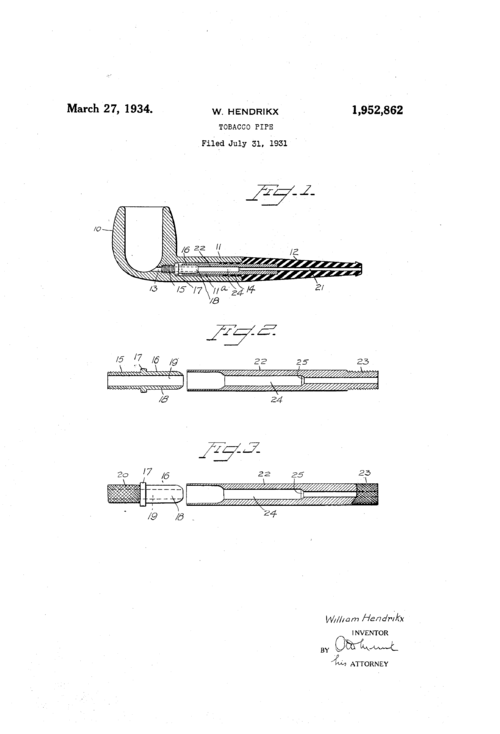
The following is the patent text from the application dated July 31, 1931, and granted March 27, 1934:
Description March 27, 1934. w HEDRlKx f 1,952,862
TOBACCO PIPE Filled July 31, 1931 BY @MWL Patented Mar. 27, 1934 UNITED STATES PATENT OFFICES TOBACCO PIPE, William Hendrikx, Ulster Park, N. Y., assignor to .Y William De Muth & Company, New York, N. Y., a corporation of New York Application July 31, 1931, Serial No. 554,168'
l Claims.
This invention relates to tobacco pipes and has particular reference to improvements in pipes having metal tubular connections in the stems to provide smoke passages, which are especially inducive to clean, dry smokes, and which avoid, as far as possible, any tendency to serve as collecting means for tobacco juice and saliva.
The present invention has for its object to provide a pipe of this character wherein the metal tubular connection is made in two sections which telescope one within the other to establish a perfectly tight smoke joint between the bowl and mouthpiece.
Another object of my invention is to V nx the separate sections of the connection in the mouthpiece and pipe stem respectively, so as to establish perfect smoke tight joints at these points.
Still another object of this invention is to provide one of the sections of the tubular connection with a smoke passage which is reduced in diameter towards the tip end for the purpose of preventing the saliva from flowing towards the bowl and mixing with the tobacco fumes to form tobacco juice.
have accomplished these objects by means of a construction and arrangement of parts hereinafter described, set forth in the appended claims and illustratively exemplified in the accompanying drawing in which: Figure 1 is a substantially longitudinal sectional view of a pipe embodying my improved metal tubular connection; Figure 2 is a side elevational View of one embodiment of the tubular connection; and Figure 3 is a similar view of a slightly modified form .f of construction.
Referring to the drawing, 10 is the bowl of a smoking pipe, 11 the stern and 12 the mouthpiece. As illustrated in Figure 1 the stem l1 is formed with a bore 11a projecting from one end to a point short of the recess in the bowl, and in communication with the latter through a reduced passage 13, the inner end of the mouthpiece is provided with a tenon 14 which is received in the open end of the bore 11a.
The passage 13 in the form of the invention illustrated in Figure 1 is enlarged at its inner end and internally threaded to receive the threaded end 15 of a spigot 16 which comprises a metal member having a collar 17, substantially midway of its length, abutting the end wall of the bore 11a, and a shank 18 projecting axially into the latter and having a rounded end, the spigot being provided with a uniform bore 19 opening at the threaded end in the smaller portion of the reduced passage 13 of the stem 11. In the modification shown in Figure 3 the end of the spigot is provided with a knurled surface 20 which is-cemented in the enlarged end of the passage 13 of the stem.
The mouthpiece 12 is provided with a bore 21 which is enlarged in the tenon 14 and for a short distance into the body of the mouthpiece itself to accommodate one end of a tubular metal piece 22 which is either knurled and cemented into the tenon and mouthpiece, as illustrated in Figures 1 and 3, or provided with an external thread 23 and screwed into an inner threaded portion of the enlarged portion of the bore 21, as illustrated in Figure 2. The tubular piece 22 is also provided with an axial bore 24 which is arranged 70 .l in three steps, the first, at the outer end being of a diameter to very closely embrace the shank end of the spigot 16 and having a rounded seat to receive the rounded end of the shank. The mid section of the bore 24 is substantially smaller than that of the outer section and it terminates short of its mouthpiece end in a beveled shoulder 25 which opens into the third section of the bore 24, the dimension of the latter section kbeing reduced as compared with the second section to correspond with the dimension of the bore Vor smoke passage 2l, in the mouthpiece i2, into which it opens.
To assemble the pipe, according to the invention, the mouthpiece tenon 14 with its projecting metal extension piece 22 is inserted into the bore 11a of the pipe stem 11 to a point where the inner end of the first section of the bore 24 is seated against the round end of the spigot shank 18. When the metal extension piece 22 has reached this point the tenon 14 will have been projected its full length into the bore of the stem 11 and the end of the mouthpiece will be seated against the end of the stem.
The wall of the bore in the outer section of the extension 22 embraces the shank 18 very closely and the joint thus formed is leak proof, thereby preventing any nicotine or moisture from finding its way into the bore 11a of the stem, which as a consequence remains dry and clean. The joint made by the connection of the spigot and tubular extension would remain tight even if a strand of tobacco were to lodge in the seat of the extension because as stated above the wall or shell of the latter is snugly over the shank 18 throughout its length.
According to the present invention, the construction and arrangement of the tubular section piece 22 and spigot 16 greatly strengthens the pipe stem 11 and mouthpiece 12, making them practically rigid when assembled.
The through smoke passage 24 in the extension piece 22 and spigot directs the smoke from the bowl 10 to contact with the cool metal wall of the spigot when the nicotine is caused to precipitate out and deposit itself on the wall of the passage at the entrance thereof, adjacent the bowl. As a result the fresh smoke passing through the smoke passage remains dry since it does not come in contact with a saturated deposit of saliva and nicotine, the dry smoke not being inducive to the formation of saliva in the mouth of the smoker. It has been found if a pipe cleaner be inserted the full length of the` smoke passage after the pipe has been in use for sometime, that only the extreme end of the cleaner will pick up any deposit, and what deposit is collected will be found to be of a dry powdery consistency containing practically no moisture. This condition is further explained by the fact that any moisture at all which may gather in the smaller section of the bore 24 of the tubular extension 22 will ow into the next larger section, the angular wall or shoulder 25 preventing any gurgling or back flow along the mouthpiece.
A perfect leak proof joint is further insured by the cement used in the connection between the spigot and the stem of the pipe and between the metal tube 22 and the mouthpiece 12, the cement used being of a special moisture resisting I claim:
1. A smoking pipe comprising a bowl portion, a stem, a mouthpiece removably tted in the stem, and a telescoping tube fixed at its one end through the tenon bore in the mouthpiece, and detachably connected at the other end to a spigot secured in the communicating bore between the bowl and stem, and partly projecting into the bore of the latter, said telescoping tube forming a continuous unbroken bore for the passage of smoke from said bowl through said mouthpiece, said bore being of successively decreasing diameter from said bowl to said mouthpiece.
2. A smoking pipe comprising a bowl portion, a stem, a mouthpiece removably fitted in the stem, a spigot fit at one end in the stem and a tubular section attached at one end to the mouthpiece and solidly connected with the free end of the spigot to form a tight joint be* tween the latter and the tubular section, said telescoping tube forming a continuous unbroken bore for the passage of smoke from said bowl through said mouthpiece, said bore being of successively decreasing diameter from said bowl to said mouthpiece.
3. A smoking pipe comprising a bowl portion, and a stem portion having a bore in communication with the bowl, a mouthpiece having a tenon removably tted in the bore of the stem, a spigot 4screwed and cemented into the smaller bore of the stem at one end and projecting towards the mouthpiece at its free end, and a tubular section fixed at one end in the mouthpiece and removably fitted about the free end of the spigot to form a tight joint, said spigot and tubular section forming a telescoping tube having a continuous unbroken bore of successively decreasing diameter from said bowl to said mouthpiece.
4. A smoking pipe comprising a bowl portion and a stem portion having a bore in communication with the bowl, the bore at the free end of the stem having a relatively larger diameter than the communicating bore between the stem and bowl, a mouthpiece having a tenon removably tted in the bore of the stem and being provided with a bore, the tenon end of which is greater in diameter than the opposite end, a spigot screwed and cemented into the smaller bore of the stem, said spigot comprising a metal tubular member with a threaded end, and at the opposite end a smooth convex shank, and having an exterior annular collar about its mid portion, said collar abutting the inner end of the enlarged portion of the bore, and a tubular extension cemented at one end in the enlarged portion of the bore of the mouthpiece and projecting beyond the tenon to fit tightly about the portion of the spigot projecting into the enlarged bore of the stem, said spigot and tubular section forming a telescoping tube having a continuous unbroken bore of successively decreasing diameter from said bowl to said mouthpiece.
5. A smoking pipe, as claimed in claim 4, in which the tubular extension is provided with a bore arranged in three steps, the first, having the largest diameter is concave at its inner end to embrace a similar prole at the free end of the spigot, the second, being of a smaller diameter and terminating in a conical shoulder which opens into the third and smallest in diameter.
6. A smoking pipe as claimed in claim 4, in which the bores are coaxial, said bores permitting the insertion of any pipe cleaner for the removal of all nicotine deposits or any obstruction therein, and without detaching any parts of said pipe.
7. A smoking pipe as claimed in claim 4, in which the telescoping tubular extension has a constant external diameter with respect to its axis, the outer surface of said telescoping tubular extension being spaced with respect to the larger l 4
Links
-->
